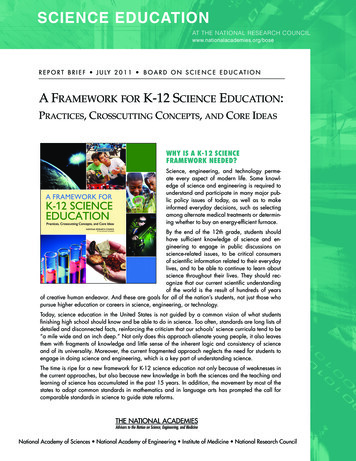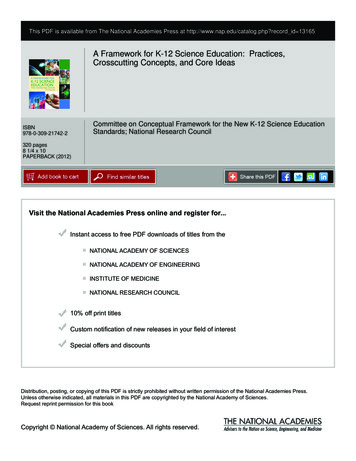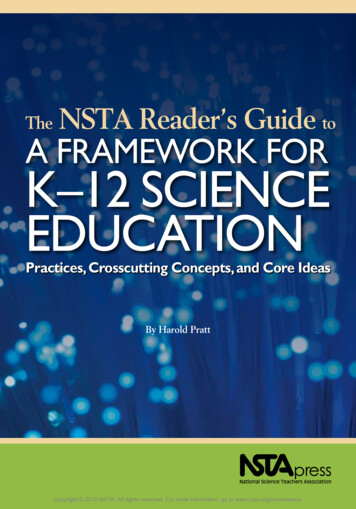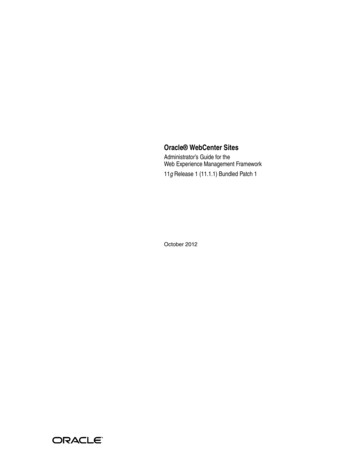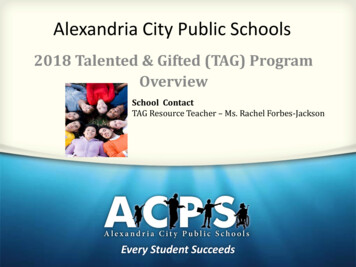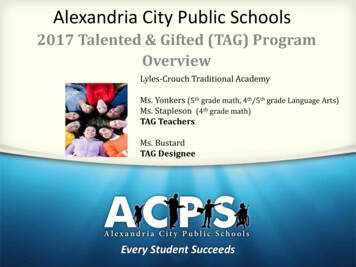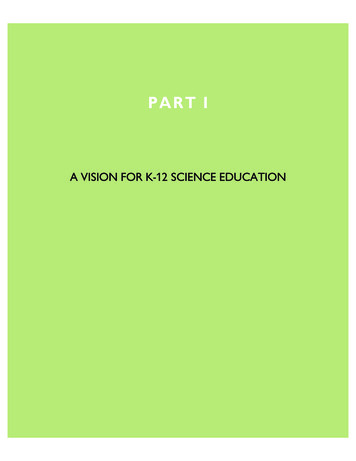
Transcription
A Framework for K-12 Science Education: Practices, Crosscutting Concepts, and Core IdeasPA RT IA VISION FOR K-12 SCIENCE EDUCATIONCopyright National Academy of Sciences. All rights reserved.
A Framework for K-12 Science Education: Practices, Crosscutting Concepts, and Core IdeasCopyright National Academy of Sciences. All rights reserved.
A Framework for K-12 Science Education: Practices, Crosscutting Concepts, and Core Ideas1A NEW CONCEPTUAL FRAMEWORKScience and engineering—significant parts of human culture that representsome of the pinnacles of human achievement—are not only major intellectual enterprises but also can improve people’s lives in fundamental ways.Although the intrinsic beauty of science and a fascination with how the worldworks have driven exploration and discovery for centuries, many of the challengesthat face humanity now and in the future—related, for example, to the environment, energy, and health—require social, political, and economic solutions thatmust be informed deeply by knowledge of the underlying science and engineering.Many recent calls for improvements in K-12 science education have focusedon the need for science and engineering professionals to keep the United Statescompetitive in the international arena. Although there is little doubt that thisneed is genuine, a compelling case can also be made that understanding scienceand engineering, now more than ever, is essential for every American citizen.Science, engineering, and the technologies they influence permeate every aspectof modern life. Indeed, some knowledge of science and engineering is required toengage with the major public policy issues of today as well as to make informedeveryday decisions, such as selecting among alternative medical treatments ordetermining how to invest public funds for water supply options. In addition,understanding science and the extraordinary insights it has produced can bemeaningful and relevant on a personal level, opening new worlds to exploreand offering lifelong opportunities for enriching people’s lives. In these contexts,learning science is important for everyone, even those who eventually choosecareers in fields other than science or engineering.7Copyright National Academy of Sciences. All rights reserved.
A Framework for K-12 Science Education: Practices, Crosscutting Concepts, and Core IdeasThe conceptual framework presented in this report of the Committee on aConceptual Framework for New K-12 Science Education Standards articulates thecommittee’s vision of the scope and nature of the education in science, engineering, and technology needed for the 21st century. It is intended as a guide to thenext step, which is the process of developing standards for all students. Thus itdescribes the major practices, crosscutting concepts, and disciplinary core ideasthat all students should be familiar with by the end of high school, and it providesan outline of how these practices, concepts, and ideas should be developed acrossthe grade levels. Engineering and technology are featured alongside the physicalsciences, life sciences, and earth and space sciences for two critical reasons: toreflect the importance of understanding the human-built world and to recognizethe value of better integrating the teaching and learning of science, engineering,and technology.By framework we mean a broad description of the content and sequenceof learning expected of all students by the completion of high school—but not atthe level of detail of grade-by-grade standards or, at the high school level, coursedescriptions and standards. Instead, as this document lays out, the frameworkis intended as a guide to standards developers as well as for curriculum designers, assessment developers, state and district science administrators, professionals responsible for science teacher education, and science educators working ininformal settings.There are two primary reasons why a new framework is needed at this time.One is that it has been 15 or more years since the last comparable effort at thenational scale, and new understandings both in science and in teaching and learning science have developed over that time. The second is the opportunity providedby a movement of multiple states to adopt common standards in mathematicsand in language arts, which has prompted interest in comparable documents forscience. This framework is the first part of a two-stage process to produce a nextgeneration set of science standards for voluntary adoption by states. The secondstep—the development of a set of standards based on this framework—is a stateled effort coordinated by Achieve, Inc., involving multiple opportunities for inputfrom the states’ science educators, including teachers, and the public.A VISION FOR K-12 EDUCATION IN THE SCIENCES AND ENGINEERINGThe framework is designed to help realize a vision for education in the sciencesand engineering in which students, over multiple years of school, actively engagein scientific and engineering practices and apply crosscutting concepts to deepen8A Framework for K-12 Science EducationCopyright National Academy of Sciences. All rights reserved.
A Framework for K-12 Science Education: Practices, Crosscutting Concepts, and Core Ideastheir understanding of the core ideas in these fields. The learning experiencesprovided for students should engage them with fundamental questions about theworld and with how scientists have investigated and found answers to those questions. Throughout grades K-12, students should have the opportunity to carry outscientific investigations and engineering design projects related to the disciplinarycore ideas.By the end of the 12th grade, students should have gained sufficient knowledge of the practices, crosscutting concepts, and core ideas of science and engineering to engage in public discussions on science-related issues, to be criticalconsumers of scientific information related to their everyday lives, and to continueto learn about science throughout their lives. They should come to appreciatethat science and the current scientific understanding of the world are the result ofmany hundreds of years of creative human endeavor. It is especially important tonote that the above goals are for all students, not just those who pursue careers inscience, engineering, or technology or those who continue on to higher education.We anticipate that the insights gained and interests provoked from studying and engaging in the practices of science and engineering during their K-12schooling should help students see how science and engineering are instrumentalin addressing major challenges that confront society today, such as generatingsufficient energy, preventing and treating diseases, maintaining supplies of cleanwater and food, and solving the problems of global environmental change. Inaddition, although not all students will choose to pursue careers in science, engineering, or technology, we hope that a science education based on the frameworkwill motivate and inspire a greater number of people—and a better representationA New Conceptual FrameworkCopyright National Academy of Sciences. All rights reserved.9
A Framework for K-12 Science Education: Practices, Crosscutting Concepts, and Core Ideas The framework is designed to help realize a vision for education inthe sciences and engineering in which students, over multiple years ofschool, actively engage in scientific and engineering practices and applycrosscutting concepts to deepen their understanding of the core ideas inthese fields. of the broad diversity of the American population—to follow these paths than isthe case today.The committee’s vision takes into account two major goals for K-12 scienceeducation: (1) educating all students in science and engineering and (2) providingthe foundational knowledge for those who will become the scientists, engineers,technologists, and technicians of the future. The framework principally concernsitself with the first task—what all students should know in preparation for theirindividual lives and for their roles as citizens in this technology-rich and scientifically complex world. Course options, including Advanced Placement (AP) or honors courses, should be provided that allow for greater breadth or depth in the science topics that students pursue, not only in the usual disciplines taught as naturalsciences in the K-12 context but also in allied subjects, such as psychology, computer science, and economics. It is the committee’s conviction that such an education, done well, will excite many more young people about science-related subjectsand generate a desire to pursue science- or engineering-based careers.Achieving the VisionThe framework is motivated in part by a growing national consensus around theneed for greater coherence—that is, a sense of unity—in K-12 science education.Too often, standards are long lists of detailed and disconnected facts, reinforcingthe criticism that science curricula in the United States tend to be “a mile wideand an inch deep” [1]. Not only is such an approach alienating to young people,but it can also leave them with just fragments of knowledge and little sense of thecreative achievements of science, its inherent logic and consistency, and its universality. Moreover, that approach neglects the need for students to develop anunderstanding of the practices of science and engineering, which is as important tounderstanding science as knowledge of its content.The framework endeavors to move science education toward a more coherentvision in three ways. First, it is built on the notion of learning as a developmental10A Framework for K-12 Science EducationCopyright National Academy of Sciences. All rights reserved.
A Framework for K-12 Science Education: Practices, Crosscutting Concepts, and Core Ideasprogression. It is designed to help children continually build on and revise theirknowledge and abilities, starting from their curiosity about what they see aroundthem and their initial conceptions about how the world works. The goal is to guidetheir knowledge toward a more scientifically based and coherent view of the sciences and engineering, as well as of the ways in which they are pursued and theirresults can be used.Second, the framework focuses on a limited number of core ideas in science and engineering both within and across the disciplines. The committeemade this choice in order to avoid shallow coverage of a large number of topicsand to allow more time for teachers and students to explore each idea in greaterdepth. Reduction of the sheer sum of details to be mastered is intended to givetime for students to engage in scientific investigations and argumentation and toachieve depth of understanding of the core ideas presented. Delimiting what is tobe learned about each core idea within each grade band also helps clarify whatis most important to spend time on and avoid the proliferation of detail to belearned with no conceptual grounding.Third, the framework emphasizes that learning about science and engineering involves integration of the knowledge of scientific explanations (i.e., contentknowledge) and the practices needed to engage in scientific inquiry and engineering design. Thus the framework seeks to illustrate how knowledge and practicemust be intertwined in designing learning experiences in K-12 science education.Limitations of This FrameworkThe terms “science,” “engineering,” and “technology” are often lumped togetheras a single phrase, both in this report and in education policy circles. But it isimportant to define what is meant by each of these terms in this report—and why.In the K-12 context, science is generally taken to mean the traditional natural sciences: physics, chemistry, biology, and (more recently) earth, space, andenvironmental sciences. In this document, we include core ideas for these disciplinary areas, but not for all areas of science, as discussed further below. This limitation matches our charge and the need of schools for a next generation of standards in these areas. Engineering and technology are included as they relate to theapplications of science, and in so doing they offer students a path to strengthentheir understanding of the role of sciences. We use the term engineering in a verybroad sense to mean any engagement in a systematic practice of design to achievesolutions to particular human problems. Likewise, we broadly use the term technology to include all types of human-made systems and processes—not in theA New Conceptual FrameworkCopyright National Academy of Sciences. All rights reserved.11
A Framework for K-12 Science Education: Practices, Crosscutting Concepts, and Core Ideaslimited sense often used in schools that equates technology with modern computational and communications devices. Technologies result when engineers applytheir understanding of the natural world and of human behavior to design waysto satisfy human needs and wants. This is not to say that science necessarily precedes technology; throughout history, advances in scientific understanding oftenhave been driven by engineers’ questions as they work to design new or improvedmachines or systems.Engineering and technology, defined in these broad ways, are included inthe framework for several reasons. First, the committee thinks it is important forstudents to explore the practical use of science, given that a singular focus on thecore ideas of the disciplines would tend to shortchange the importance of applications. Second, at least at the K-8 level, these topics typically do not appear elsewhere in the curriculum and thus are neglected if not included in science instruction. Finally, engineering and technology provide a context in which students cantest their own developing scientific knowledge and apply it to practical problems;doing so enhances their understanding of science—and, for many, their interest inscience—as they recognize the interplay among science, engineering, and technology. We are convinced that engagement in the practices of engineering design is asmuch a part of learning science as engagement in the practices of science [2].It is important to note, however, that the framework is not intended todefine course structure, particularly at the high school level. Many high schoolsalready have courses designated as technology, design, or even engineering thatgo beyond the limited introduction to these topics specified in the framework.These courses are often taught by teachers who have specialized expertise anddo not consider themselves to be science teachers. The committee takes no position on such courses—nor, in fact, on any particular set of course sequenceoptions for students at the high school level. We simply maintain that someintroduction to engineering practice, the application of science, and the interrelationship of science, engineering, and technology is integral to the learning ofscience for all students. The committee’s vision takes into account two major goals for K-12science education: (1) educating all students in science and engineeringand (2) providing the foundational knowledge for those who will becomethe scientists, engineers, technologists, and technicians of the future.12A Framework for K-12 Science EducationCopyright National Academy of Sciences. All rights reserved.
A Framework for K-12 Science Education: Practices, Crosscutting Concepts, and Core IdeasMore generally, this framework should not be interpreted as limitingadvanced courses that go beyond the material included here—all students at thehigh school level should have opportunities for advanced study in areas of interestto them, and it is hoped that, for many, this will include further study of specificscience disciplines in honors or AP courses. Such course options may include topics, such as neurobiology, and even disciplines, such as economics, that are notincluded in this framework.Social, Behavioral, and Economic SciencesAlthough some aspects of the behavioral sciences are incorporated in the framework as part of life sciences, the social, behavioral, and economic sciences are notfully addressed. The committee did not identify a separate set of core ideas forthese fields for several reasons.First, the original charge to the committee did not include these disciplines.Second, social, behavioral, and economic sciences include a diverse array of fields(sociology, economics, political science, anthropology, all of the branches of psychology) with different methods, theories, relationships to other disciplines ofscience, and representation in the K-12 curriculum. Although some are currentlyrepresented in grades K-12, many are not or appear only in courses offered at thehigh school level.Third, the committee based the framework on existing documents that outline the major ideas for K-12 science education, including the National ScienceEducation Standards (NSES) [3], the Benchmarks for Science Literacy [4] and theaccompanying Atlas [5], the Science Framework for the 2009 National Assessmentof Educational Progress (NAEP) [6], and the Science College Board Standards forCollege Success [7]. Most of these documents do not cover all of the fields that arepart of the social, behavioral, and economic sciences comprehensively, and someomit them entirely.Fourth, understanding how to integrate the social, behavioral, and economicsciences into standards, given how subjects are currently organized in the K-12system, is especially complex. These fields have typically not been included as partof the science curriculum and, as noted above, are not represented systematicallyin some of the major national-level documents that identify core concepts for K-12science. Also, many of the topics related to the social, behavioral, and economicsciences are incorporated into curricula or courses identified as social studies andmay be taught from a humanities perspective. In fact, the National Council for theSocial Studies has a set of National Curriculum Standards for Social Studies thatA New Conceptual FrameworkCopyright National Academy of Sciences. All rights reserved.13
A Framework for K-12 Science Education: Practices, Crosscutting Concepts, and Core Ideasincludes standards in such areas as psychology, sociology, geography, anthropology, political science, and economics [8].The limited treatment of these fields in this report’s framework should not,however, be interpreted to mean that the social, behavioral, and economic sciences should be omitted from the K-12 curriculum. On the contrary, the committee strongly believes that these important disciplines need their own frameworkfor defining core concepts to be learned at the K-12 level and that learning (thedevelopment of understanding of content and practices) in the physical, life, earth,and space sciences and engineering should be strongly linked with parallel learningin the social, behavioral, and economic sciences. Any such framework must alsoaddress important and challenging issues of school and curriculum organizationaround the domain of social sciences and social studies.Our committee has neither the charge nor the expertise to undertake thatimportant work. Thus, although we have included references to some of thesocial, behavioral, and economic issues connected to the sciences that are the focusof our own framework (see, for example, Core Idea 2 in engineering, technology, and applications of science), we do not consider these references to definethe entirety of what students should learn or discuss about social, behavioral, andeconomic sciences.In a separate effort, the National Research Council (NRC) has plans to convene a workshop to begin exploring a definition of what core ideas in the social,behavioral, and economic sciences would be appropriate to teach at the K-12 leveland at what grade levels to introduce them. As noted above, there are many quitedistinct realms of study covered by the terms. Given the multiplicity and varietyof disciplines involved, only a few of which are currently addressed in any way inK-12 classrooms, there is much work to be done to address the role of these sciences in the development of an informed 21st-century citizen. It is clear, however,to the authors of this report that these sciences, although different in focus, dohave much in common with the subject areas included here, so that much of whatthis report discusses in defining scientific and engineering practices and crosscutting concepts has application across this broader realm of science.Computer Science and StatisticsComputer science and statistics are other areas of science that are not addressedhere, even though they have a valid presence in K-12 education. Statistics is basically a subdiscipline of mathematical sciences, and it is addressed to some extentin the common core mathematics standards. Computer science, too, can be seen14A Framework for K-12 Science EducationCopyright National Academy of Sciences. All rights reserved.
A Framework for K-12 Science Education: Practices, Crosscutting Concepts, and Core Ideasas a branch of the mathematical sciences, as well as having some elements of engineering. But, again, because this area of the curriculum has a history and a teaching corps that are generally distinct from those of the sciences, the committee hasnot taken this domain as part of our charge. Once again, this omission should notbe interpreted to mean that computer science or statistics should be excluded fromthe K-12 curriculum. There are aspects of computational and statistical thinkingthat must be understood and applied in learning about the sciences, and we identify these aspects, along with mathematical thinking, in our discussion of sciencepractices in Chapter 3.ABOUT THIS REPORTThe Committee on a Conceptual Framework for New K-12 Science EducationStandards was established by the NRC to undertake the study on which thisreport is based. Composed of 18 members reflecting a diversity of perspectivesand a broad range of expertise, the committee includes professionals in the naturalsciences, mathematics, engineering, cognitive and developmental psychology, thelearning sciences, education policy and implementation, research on learning science in the classroom, and the practice of teaching science.The committee’s charge was to develop a conceptual framework thatwould specify core ideas in the life sciences, physical sciences, earth and spacesciences, and engineering and technology, as well as crosscutting concepts andpractices, around which standards should be developed. The committee was alsocharged with articulating how these disciplinary ideas and crosscutting conceptsintersect for at least three grade levels and to develop guidance for implementation (see Box 1-1).Scope and ApproachThe committee carried out the charge through an iterative process of amassinginformation, deliberating on it, identifying gaps, gathering further information tofill these gaps, and holding further discussions. In our search for particulars, weheld three public fact-finding meetings, reviewed published reports and unpublished research, and commissioned experts to prepare and present papers. At ourfourth meeting, we deliberated on the form and structure of the framework andon the content of the report’s supporting chapters, to prepare a draft frameworkfor public release in July 2010. During the fifth and sixth meetings, we consideredthe feedback received from the public and developed a plan for revising the draftframework based on this input (see below for further details).A New Conceptual FrameworkCopyright National Academy of Sciences. All rights reserved.15
A Framework for K-12 Science Education: Practices, Crosscutting Concepts, and Core IdeasBOX 1-1COMMITTEE CHARGEAn ad hoc committee will develop and define a framework to guide the development of science educationstandards. In conducting the study and preparing its report, the committee will draw on current research on science learning as well as research and evaluation evidence related to standards-based education reform. This willinclude existing efforts to specify central ideas for science education, including the National Science EducationStandards, AAAS Benchmarks, the 2009 NAEP Framework, and the redesign of the AP courses by the CollegeBoard.The conceptual framework developed by the committee will identify and articulate the core ideas in sciencearound which standards should be developed by considering core ideas in the disciplines of science (life sciences,physical sciences, earth and space sciences, and applied sciences) as well as crosscutting ideas such as mathematization,* causal reasoning, evaluating and using evidence, argumentation, and model development. The committee will illustrate with concrete examples how crosscutting ideas may play out in the context of select coredisciplinary ideas and articulate expectations for students’ learning of these ideas for at least three key gradelevels. In parallel, the committee will develop a research and development plan to inform future revisions of thestandards. Specifically in its consensus report, the committee willssssssidentify a small set of core ideas in each of the major science disciplines, as well as those ideas that cutacross disciplines, using a set of criteria developed by the committeedevelop guidance on implementation of the frameworkarticulate how these disciplinary ideas and crosscutting ideas intersect for at least three grade levelscreate examples of performance expectationsdiscuss implications of various goals for science education (e.g., general science literacy, college preparation,and workforce readiness) on the priority of core ideas and articulation of leaning expectationsdevelop a research and development plan to inform future revisions of the standards*Mathematization is a technical term that means representing relationships in the natural world using mathematics.The nature of the charge—to identify the scientific and engineering ideasand practices that are most important for all students in grades K-12 to learn—means that the committee ultimately had to rely heavily on its own expertise andcollective judgments. To the extent possible, however, we used research-basedevidence and past efforts to inform these judgments. Our approach combined16A Framework for K-12 Science EducationCopyright National Academy of Sciences. All rights reserved.
A Framework for K-12 Science Education: Practices, Crosscutting Concepts, and Core Ideasevidence on the learning and teaching of science and engineering with a detailedexamination of previous science standards documents. It is important to note thateven where formal research is limited, the report is based on the collective experience of the science education and science education research communities. All thepractices suggested have been explored in classrooms, as have the crosscuttingconcepts (though perhaps under other names such as “unifying themes”).Design TeamsThe committee’s work was significantly advanced by the contributions of fourdesign teams, which were contracted by the NRC to prepare materials thatdescribed the core ideas in the natural sciences and engineering and outlined howthese ideas could be developed across grades K-12. Each team had a designatedleader who provided guidance and interacted frequently with the committee. Thematerials developed by the teams form the foundation for the core disciplinaryideas and grade band endpoints described in this report (Chapters 5-8). A list ofthe design team participants appears in Appendix D.The design teams were asked to begin their work by considering theideas and practices described in the NSES [3], AAAS Benchmarks [4], ScienceFramework for the 2009 NAEP [6], and Science College Board Standards forCollege Success [7] as well as the relevant research on learning and teaching inscience. The teams prepared drafts and presented them to the committee during the closed portions of our first three meetings. Between meetings, the teamsrevised their drafts in response to committee comments. Following the releaseof the July 2010 draft (see the next section), the leaders of the design teamscontinued to interact with committee members as they planned the revisions ofthe draft framework. No members of the design teams participated in the discussions during which the committee reached consensus on the content of thefinal draft. The framework and subsequent standards will not lead to improvementsin K-12 science education unless the other components of the system—curriculum, instruction, professional development, and assessment—change so that they are aligned with the framework’s vision. A New Conceptual FrameworkCopyright National Academy of Sciences. All rights reserved.17
A Framework for K-12 Science Education: Practices, Crosscutting Concepts, and Core IdeasPublic FeedbackThe committee recognized early in the process that obtaining feedback from abroad range of stakeholders and experts would be crucial to the success of theframework. For this reason, we obtained permission from the NRC to release adraft version of the framework for public comment.The draft version was prepared, underwent an expedited NRC review, andwas released in early July 2010. It was then posted online for a period of threeweeks, during which time individuals could submit comments through an onlinesurvey. In addition, NRC staff contacted over 40 organizations in science, engineering, and education, notifying them of the public comment period and askingthem to hold focus groups to gather feedback from members or to at least notifytheir members of the opportunity to comment online. The NRC also workedclosely with the National Science Teachers Association, the American Associationfor the Advancement of Science, Achieve, Inc., and the Council of State ScienceSupervisors both to facilit
8 A Framework for K-12 Science Education The conceptual framework presented in this report of the Committee on a Conceptual Framework for New K-12 Science Education Standards articulates the committee’s vision of the scope and nature of the education in science,



